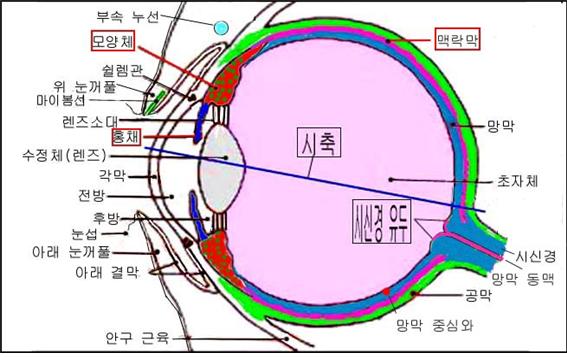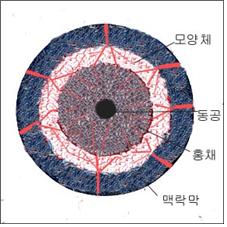포도막염 Uveitis

그림 132. 포도막–홍채+모양체+맥락막의 해부도
모양체, 쉴렘관, 위 눈꺼풀, 렌즈소대(지지인대), 홍채, 수정체(렌즈), 각막, 전방, 후방, 눈썹, 아래 눈꺼풀, 안구 근육, 망막, 초자체, 시신경, 공막, 아래 결막, 망막 중심오목(망막 중심와). Copyright ⓒ 2011 John Sangwon Lee, M.D., FAAP

그림 133. 포도막–홍채+모양체+맥락막의 전면도
소스: Gray;s anantomy
-
포도막은 홍채, 모양체(성모체), 맥락막을 포함한 안구의 혈관성 중간막이다.
-
포도막에 생긴 염증을 포도막염이라 한다.
-
홍체에 생긴 염증을 홍채염(Iritis), 모양체에 생긴 염증을 모양체염(Cyclitis), 맥락막에 생긴 염증을 맥락막염(Chorioditis)이라 한다.
-
홍채염만 생길 수도 있고, 모양체염만 생길 수도 있고 맥락막염만 생길 수 있다.
-
그러나 홍채염과 모양체염이 같이 올 수도 있다.
-
이런 경우를 홍채모양체염(Iridocyclitis)이라고 한다.
-
맥락막염만 생길 수도 있지만 맥락막과 망막에 동시 염증이 생기는 것이 보통이다.
-
그래서 맥락막망막염(Chorioretinitis)이 더 흔히 생긴다.
포도막염의 원인
-
전신 질환,
-
감염성 질환,
-
비감염성 염증,
-
외부 독,
-
외상 등으로 포도막의 일부 또는 전부에 염증이 생길 수 있다.
-
연소성 류마토이드 관절염,
-
가와사키병,
-
유육종증(Sarcoidosis)
-
헤르페스바이러스 각막염,
-
이물질,
-
외상,
-
박테리아 감염,
-
바이러스성 감염 등으로 홍채염(Iritis)이 생길 수 있다.
포도막염의 증상 징후
1. 홍채염(Iritis)의 증상 징후
-
모양체(섬모체)염과 같이 생길 수 있고 홍채염만 생길 수 있다.
-
안구 통증, 눈이 부시고, 눈물이 난다.
-
결막이 붓고 시력 장애도 생길 수 있다.
-
각막염도 생길 수 있고 각막이 변성될 수 있다.
-
백내장도 생길 수 있다.
2.맥락막염의 증상 징후
-
맥락막염과 망막염과 같이 생기는 것이 보통이고
-
맥락막 망막염을 후 포도막염이라 하고
-
홍채모양체염(Iridocyclitis)은 전 포도막염이라 한다.
-
망막염(Chorioditis)만 생기는 경우는 드물다.
-
맥락막 망막염은 톡소플라스모시스, 히스토플라스마증, 유육종증, 매독, 결핵, 톡소플라스마증 등으로 생기고 시력 장애, 녹내장, 망막 박리도 생기고 그로 인해 증상 징후가 생긴다.
포도막염의 진단 치료
-
증상 징후, 병력, 검진 등으로 진단할 수 있다.
-
원인에 따라 치료한다.
Uveitis 포도막염

Figure 132. Anatomical diagram of the uvea-iris + ciliary body + choroid Ciliary body, Schlemm’s canal, upper eyelid, lens ligament (supporting ligament), iris, lens (lens), cornea, anterior, posterior, eyebrow, lower eyelid, eye muscle, retina, vitreous body, optic nerve, sclera, inferior conjunctiva, central fovea retina (retinal fovea). Copyright ⓒ 2011 John Sangwon Lee, M.D., FAAP

Figure 133. Anterior view of the uvea-iris + ciliary body + choroid Source: Gray;s anantomy • The uvea is the vascular intermediate membrane of the eye, including the iris, ciliary body, and choroid.
• Inflammation of the uvea is called uveitis.
• Inflammation in the iris is called iritis, inflammation in the ciliary body is called Cyclitis, and inflammation in the choroid is called chorioditis.
• It can be iritis alone, ciliary inflammation alone, or choroiditis alone.
• However, iritis and ciliary infection may coexist.
• This case is called iridocyclitis.
• Although choroiditis alone may occur, it is common to have simultaneous inflammation of the choroid and retina.
• So Chorioretinitis is more common.
Causes of uveitis
• systemic diseases;
• Infectious diseases;
• non-infectious inflammation;
• external poison;
• Some or all of the uvea may become inflamed due to trauma, etc.
• Juvenile rheumatoid arthritis;
• Kawasaki disease;
• Sarcoidosis
• herpesvirus keratitis;
• Foreign body;
• trauma,
• bacterial infection;
• Viral infection can cause iritis.
Signs, symptoms of uveitis
1. Symptoms, signs of Iritis
• It can occur with ciliary body (ciliary) inflammation or only iritis.
• Eye pain, dazzling, and watery eyes.
• The conjunctiva may swell and cause vision problems.
• Keratitis may also develop and corneal degeneration may occur.
• Cataracts may also develop.
2. Symptoms. signs of choroiditis
• Common with choroiditis and retinitis
• Choroidal retinitis is called retrouveitis.
• Iridocyclitis is called anterior uveitis.
• Retinitis alone is rare.
• Choroidal retinitis is caused by toxoplasmosis, histoplasmosis, sarcoidosis, syphilis, tuberculosis, and toxoplasmosis, as well as visual impairment, glaucoma, and retinal detachment, resulting in symptomatic symptoms.
Diagnosis, treatment of uveitis
• It can be diagnosed by symptoms, medical history, and examination.
• Treat according to the cause.
출처 및 참조문헌
- www.drleepediatrics.com 제 6권 신생아 성장 발육 육아 질병
-
www.drleepediatrics.com제7권 소아청소년 감염병
- www.drleepediatrics.com제8권 소아청소년 호흡기 질환
- www.drleepediatrics.com제9권 소아청소년 소화기 질환
- www.drleepediatrics.com제10권. 소아청소년 신장 비뇨 생식기 질환
- www.drleepediatrics.com제11권. 소아청소년 심장 혈관계 질환
- www.drleepediatrics.com제12권. 소아청소년 신경 정신 질환, 행동 수면 문제
- www.drleepediatrics.com제13권. 소아청소년 혈액, 림프, 종양 질환
- www.drleepediatrics.com제14권. 소아청소년 내분비, 유전, 염색체, 대사, 희귀병
- www.drleepediatrics.com제15권. 소아청소년 알레르기, 자가 면역질환
- www.drleepediatrics.com제17권. 소아청소년 피부 질환
- www.drleepediatrics.com제18권. 소아청소년 이비인후(귀 코 인두 후두) 질환
- www.drleepediatrics.com제19권. 소아청소년 안과 (눈)질환
- Red book 29th-31st edition 2021
- Nelson Text Book of Pediatrics 19th — 21st Edition
- The Johns Hopkins Hospital, The Harriet Lane Handbook, 22nd edition
-
Childhood Emergencies in the Office, Hospital and Community, American Academy of Pediatrics
-
Emergency Medical Service for Children, By Ross Lab. May 1989. p.10
-
Emergency care, Harvey grant, and Robert Murray
-
Emergency Care Transportation of Sick and Injured American Academy of Orthopaedic Surgeons
-
Emergency Pediatrics A Guide to Ambulatory Care, Roger M. Barkin, Peter Rosen
-
Immediate care of the acutely ill and injured, Hugh E. Stephenson, Jr
-
The Critically Ill Child, Diagnosis and Management, Edited by Clement A. Smith
-
Emergency Medical Services for Children: The Role of the Primary Care Provider, America Academy of Pediatrics
-
Quick Reference To Pediatric Emergencies, Delmer J. Pascoe, M.D., Moses Grossman, M.D. with 26 contributors
-
Manual of Emergency Care
-
응급환자관리 정담미디어
-
소아가정간호백과–부모도 반의사가 되어야 한다, 이상원
-
Neonatal Resuscitation American heart Association
-
Neonatology Jeffrey J.Pomerance, C. Joan Richardson
-
Pediatric Resuscitation Pediatric Clinics of North America, Stephen M. Schexnayder, M.D.
-
Pediatric Critical Care, Pediatric Clinics of North America, James P. Orlowski, M.D.
-
Preparation for Birth. Beverly Savage and Dianna Smith
- Infectious disease of children, Saul Krugman, Samuel L Katz, Ann A. Gershon, Catherine Wilfert
-
The Harriet Lane Handbook 19th Edition
-
소아과학 대한교과서
-
제1권 소아청소년 응급의료 참조문헌과 출처
-
Other
Copyright ⓒ 2015 John Sangwon Lee, MD., FAAP
“부모도 반의사가 되어야 한다”-내용은 여러분들의 의사로부터 얻은 정보와 진료를 대신할 수 없습니다.
“The information contained in this publication should not be used as a substitute for the medical care and advice of your doctor. There may be variations in treatment that your doctor may recommend based on individual facts and circumstances. “Parental education is the best medicine.”